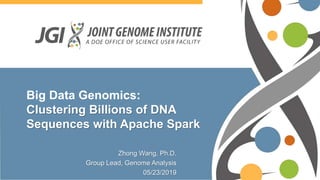
Big Data Genomics: Clustering Billions of DNA Sequences with Apache Spark
- 1. Big Data Genomics: Clustering Billions of DNA Sequences with Apache Spark Zhong Wang, Ph.D. Group Lead, Genome Analysis 05/23/2019
- 2. 1999-2007 2008-now: JGI as the DOE sequencing center dedicated to plants and microbes. DOE JGI: A brief history
- 3. Our Mission 3 DOE JGI, Serving as a genomic user facility in support of the DOE missions: • Walnut Creek 1999-2019 • Berkeley, CA • 250 employees • $70M annual budget bioenergy, carbon cycling, & biogeochemistry
- 4. Our sequencer lineups Miseq NextSeq 500 Hiseq 2500 PacBio RSII Oxford Nanopore Short-read technologies Long-read technologies Novaseq 6000 PacBio Sequel MinION Promethion 200Tb sequencing data in FY18 Illumina
- 5. Genomics big data is not typical big data Unstructured Volume, variety veracity increases during analytics
- 6. Metagenome is the genome of a microbial community 10s "intimate kiss" = 80 million bacteria Metagenomics questions: Who are there? What they do? How they interact?
- 7. Microbial communities are “dark matters” Number of Species Cow ~6000 Human ~1000 Soil, >100000 >90% of the species haven’t been seen before
- 8. Metagenome sequencing and assembly Harvest microbes Extract DNA Shear, & Sequencing Assembly Short Reads Reconstructed genomes Microbial Community Metagenome DNA
- 9. The metagenome assembly problem Library of Books Shredded Library “reconstructed” Library Genome ~= Book Metagenome ~= Library Sequencing ~= sampling the pieces and read them
- 10. Scale is an enemy 1 10 100 1,000 10,000 100,000 1,000,000 Typical Human Cow Ocean Soil Gigabases (Gb)
- 11. Complexity is another… Remove contaminants, sequencing errors Overlap graph de bruijn graph Contigs or clusters Repetitive elements Homologous genes Horizontal transferred genes
- 12. The ideal solution and the failed ones Easy to develop Robust Scale to big data Efficient BigMem • Easy to develop • Expensive • Not scale MPI • Fast • Hard to develop • Not robust Hadoop • Easy to develop • Scale • Slow
- 13. Addressing big data: Apache Spark • New scalable programming paradigm • Compatible with Hadoop-supported storage systems • Improves efficiency through: • In-memory computing primitives • General computation graphs • Improves usability through: • Rich APIs in Java, Scala, Python • Interactive shell Scale to big data Efficient Easy to develop Robust
- 14. Goal: Metagenome read clustering Read clustering can reduce metagenome problem to single-genome problem • Parallel Processing • Individualized optimization Reads Read clusters
- 15. Algorithm 2 3 1 Node: Read Edge: number of kmers two reads share Kmer to reads is what word to sentence Read graph containing all reads Graph Partitioning: LPA Kmer-mapping reads Graph Construction and Edge Reduction Label Propagation Algorithm
- 16. Clustering performance on long reads Read length = 500-20,000
- 17. Short reads? Not so much Read length = 150
- 18. Can long reads come in rescue?
- 20. A tradeoff between cost and performance 0 50 100 150 200 250 0% 20% 40% 60% 80% 100% mean cluster size (K) #reads (M) #clusters Percent of long reads used
- 21. Short-read only: there is still a way out
- 22. More samples, better results: one vs 50
- 23. More data, better results: clustering success is dependent on coverage
- 24. Can we scale to big data?
- 25. Hardware and software environments Customized EMR Bridge nodes 20 20 8 cores 8 (160) 8 (160) 28 (224) memory 64 (1280) 61 (1220) 128 (1024) Hadoop 2.7.3 2.7.3 2.7.2 Spark 2.1.1 2.2.0 2.1.0
- 26. A quick reminder… 2 3 1 Node: Read Edge: number of kmers two reads share Kmer to reads is what word to sentence Read graph containing all reads Graph Partitioning: LPA Kmer-mapping reads (KMR) Graph Construction and Edge Reduction (Edges) Label Propagation Algorithm (LPA)
- 27. Scale to bigger data volume on a 20-node cluster 0 200 400 600 800 20 40 60 80 100 ExecutionTime(mins) Data Size (GB) KMR Edges LPA Total
- 28. Increasing nodes on a 50G-dataset 0 100 200 300 400 500 25 50 75 100 ExecutionTime(mins) Number of nodes 50G KMR Edges LPA Total
- 29. Fine tune parallelism 0 50 100 150 200 250 300 350 1 2 3 4 5 6 7 8 ExecutionTIme(mins) Spark default parallelism (log10) 50G 20G
- 30. Dataset complexity vs performance 146.33 44.5 0 20 40 60 80 100 120 140 160 Human Iso-Seq Alzheimer(PacBio) Cow Rumen(Illumina) ExecutionTime(mins) KMR Edges LPA
- 31. Platform comparison: Clouds and HPC Customized EMR Bridge nodes 20 20 8 cores 8 (160) 8 (160) 28 (224) memory 64 (1280) 61 (1220) 128 (1024) Time (min) 106 105 126
- 32. Now we have a big hammer…
- 33. Clustering for identifying genome contaminants Russula 70Mb Bradyrhizobium 7.2Mb Collimonas: 5.3Mb
- 34. Targeting big metagenome projects Dr. Morgan-Kiss @ Miami University Dr. Slonczewski @Kenyon University Two lakes, 1.2Tbp
- 35. Acknowledgements Spark Team Lizhen Shi @FSU Xiandong Meng Kexue Li, LiliWang and Li Deng @Shanghai U Kurt Labutti Elizabeth Tseng @PacBio Lisa Gerhardt , Evan Racah @ NERSC Yong Qin, Gary Jung, Greg Kurtzer, Bernard Li, @ HPC Philip Blood, Bryon Gill @PSC
